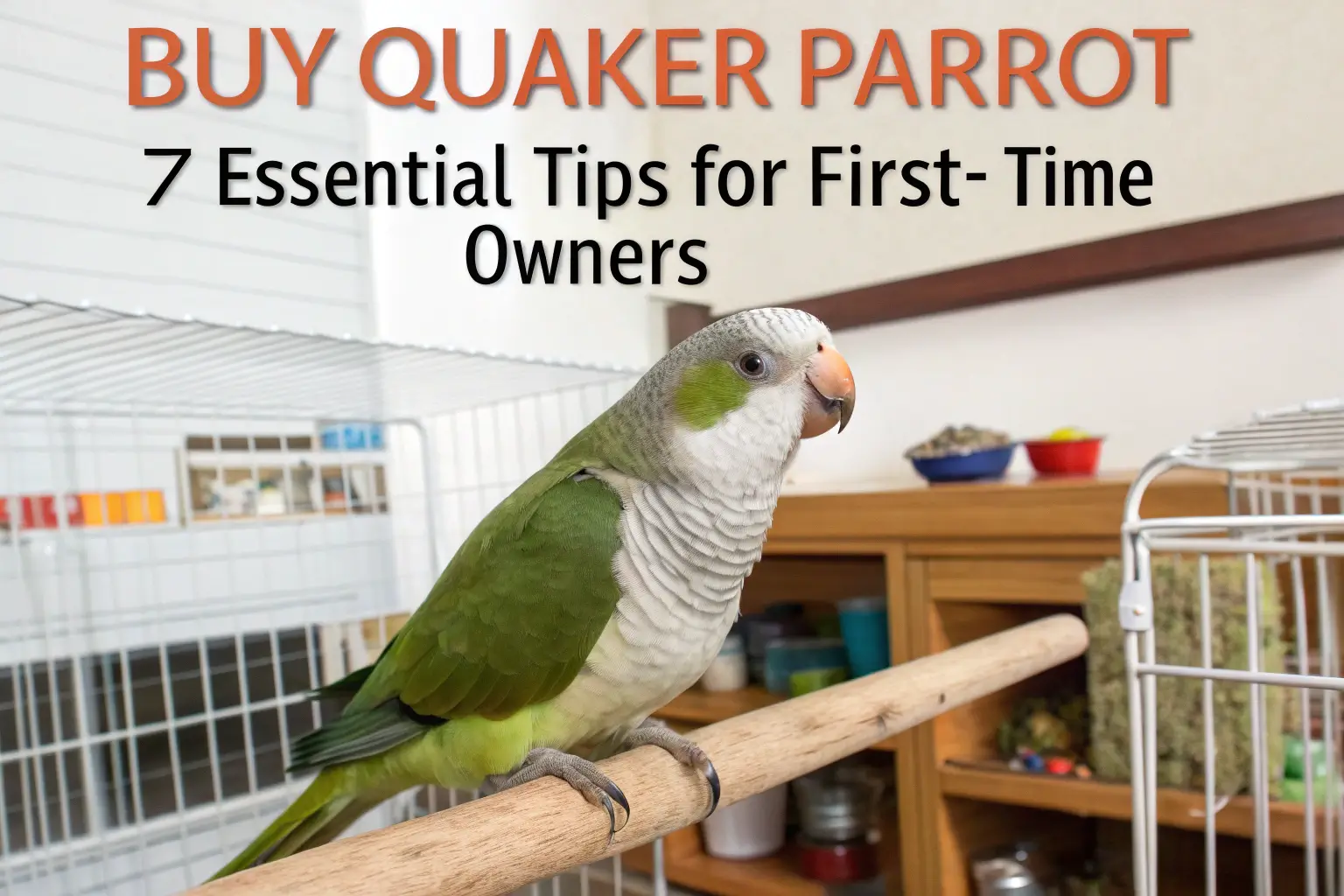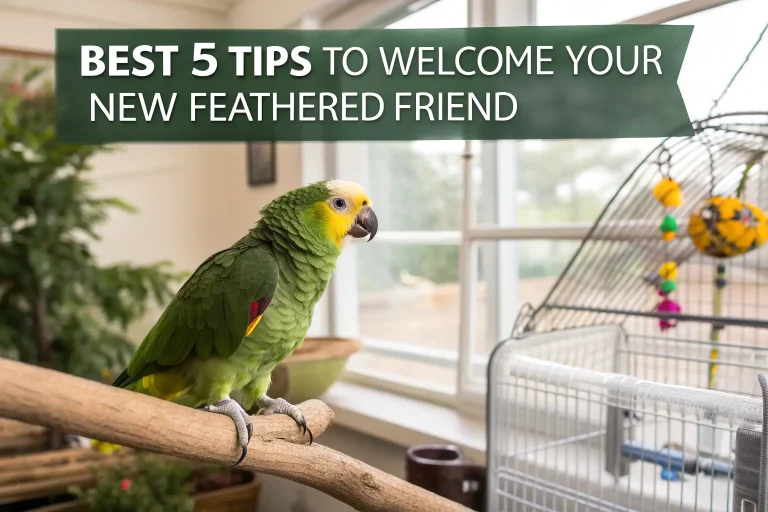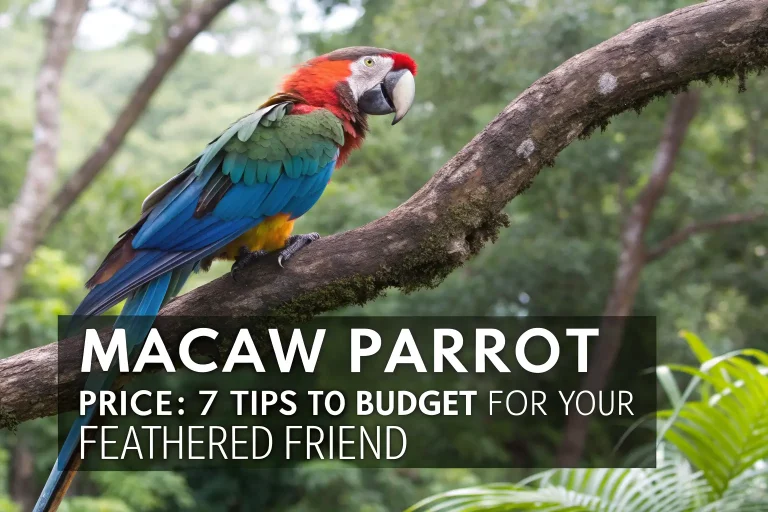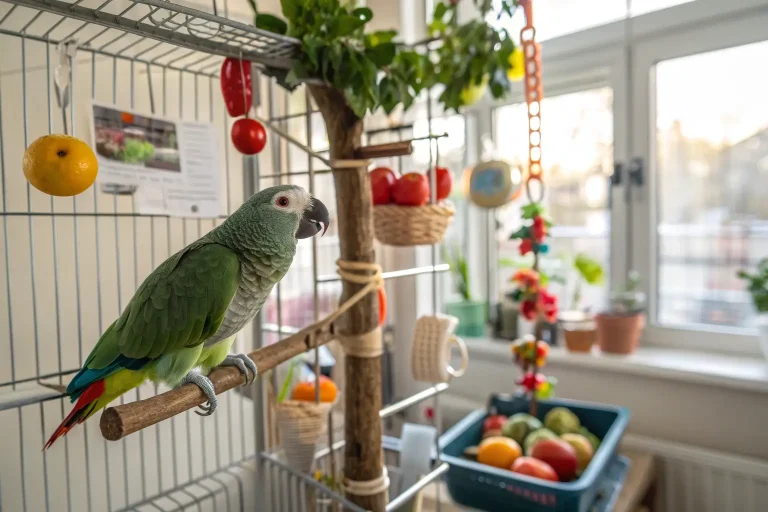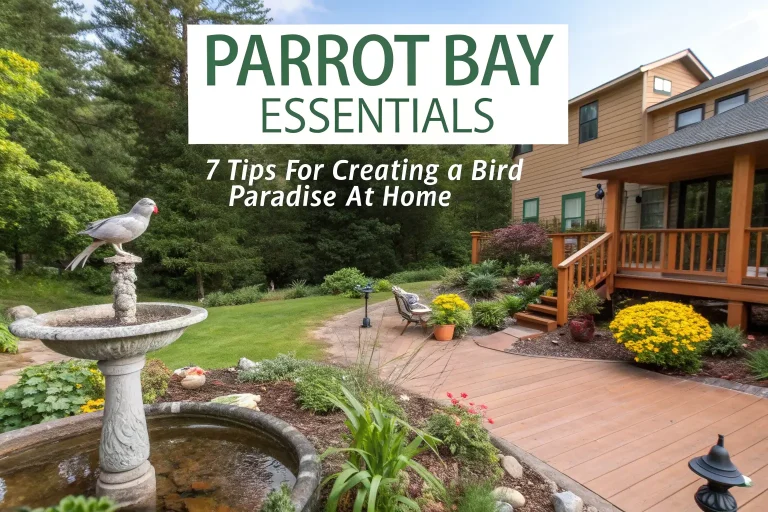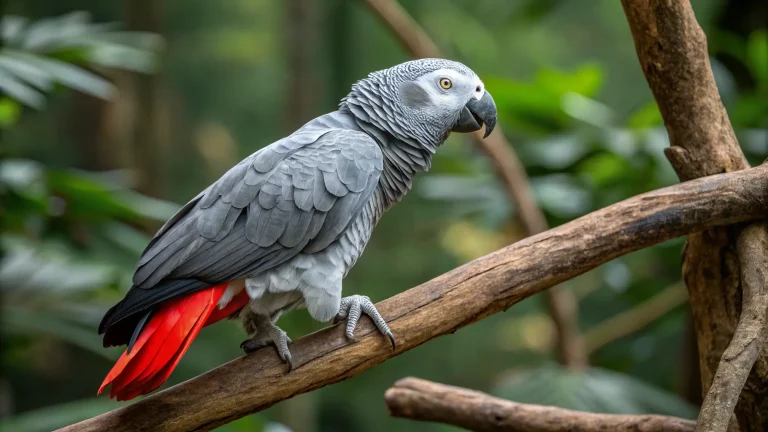Buy Quaker Parrot: 7 Essential Tips for First-Time Owners
Looking to buy Quaker parrot? Get expert advice with our 7 essential tips for first-time owners to ensure a happy, healthy pet. Discover our guide now!
Introduction
The Quaker parrot, also known as the Monk parakeet, is a charming, intelligent, and highly social bird that has become increasingly popular as a companion pet. With their vibrant green plumage, distinctive gray breast, and remarkable speaking abilities, these medium-sized parrots offer a delightful blend of personality and manageable care requirements for those looking to buy Quaker parrot companions.
Native to South America, these birds have adapted remarkably well to life with humans, forming strong bonds with their owners while maintaining their naturally playful and curious disposition. Before you buy Quaker parrot pets, it’s crucial to understand their unique needs and characteristics to ensure you can provide the appropriate care these fascinating creatures deserve.
Did you know that Quaker parrots are among the most skilled nest-builders in the parrot world? In the wild, they construct elaborate stick nests with multiple chambers and entrances, showcasing their impressive problem-solving abilities – the same intelligence that makes them such engaging pets!
Species Overview
Scientific Name: Myiopsitta monachus
Physical Characteristics: Quaker parrots typically reach 11-12 inches in length and weigh between 90-120 grams. Their most distinguishing feature is their vibrant green body contrasted with a gray breast, throat, and cheeks (resembling a Quaker’s habit, hence the name). They have a sharp, hooked beak and a relatively long, pointed tail. Males and females appear virtually identical, making visual gender identification challenging.
Subspecies: There are four recognized subspecies of Quaker parrots:
- Myiopsitta monachus monachus (the nominate subspecies)
- Myiopsitta monachus calita (smaller with less gray on the breast)
- Myiopsitta monachus cotorra (larger with more extensive gray areas)
- Myiopsitta monachus luchsi (found in Bolivia, with more blue in their plumage)
When you buy Quaker parrot pets in the US, you’re most likely getting the nominate subspecies, though some color mutations like blue, cinnamon, and lutino are also available through specialized breeders.
Habitat and Distribution
Natural Habitat: In their native environment, Quaker parrots inhabit open woodland areas, savannas, and scrublands. They thrive in moderately warm climates with access to trees for nesting and open areas for foraging. Unlike many parrot species that nest in tree hollows, Quakers build large communal stick nests, often creating veritable parrot condominiums that can house multiple families.
Geographic Range: Quaker parrots are indigenous to Argentina, Bolivia, Brazil, Paraguay, and Uruguay. However, feral populations have successfully established themselves in many parts of the world, including numerous states across the US, parts of Europe, and even Japan, demonstrating their remarkable adaptability.
Adaptations: These resourceful birds have evolved exceptional adaptation capabilities, enabling them to survive in diverse environments. Their unique nest-building behavior provides insulation against both hot and cold temperatures, allowing them to thrive in climates significantly colder than their native range. This adaptability is partly why they’ve successfully established feral colonies in cities as far north as Chicago and New York.
Diet and Feeding Habits
What They Eat: When you buy Quaker parrot pets, understanding their dietary needs is essential. In the wild, Quakers maintain an omnivorous diet consisting primarily of seeds, fruits, berries, nuts, blossoms, and the occasional insect. They particularly favor sunflower seeds, though these should be limited in captivity due to their high fat content.
Foraging Behavior: Quaker parrots are naturally active foragers, spending significant portions of their day searching for food. They use their strong beaks to crack open seeds and nuts and their dexterous feet to manipulate food items. In captivity, providing foraging toys and puzzle feeders helps satisfy this natural behavior.
Dietary Needs: A healthy captive Quaker parrot diet should include:
- High-quality pelleted food (60-70% of diet)
- Fresh vegetables (20-30%) including leafy greens, carrots, and bell peppers
- Fresh fruits (10%) such as apples, berries, and melons
- Occasional nuts and seeds as treats
- Clean, fresh water available at all times
Avoid feeding avocados, chocolate, alcohol, caffeine, and foods high in salt or sugar, as these can be toxic to parrots.
Behavior and Social Structure
Social Behavior: Quaker parrots are exceptionally social birds that live in large, noisy colonies in the wild. This strong social instinct transfers to captivity, making them form intense bonds with their human companions. When you buy Quaker parrot pets, be prepared for a bird that demands regular interaction and can become depressed if left alone for extended periods.
Communication: These birds are renowned for their vocal abilities. They can develop impressive vocabularies of 50+ words and even learn simple sentences. Beyond mimicry, they communicate through various calls, from gentle chirps to loud screams when excited or alarmed. They also use body language, with crest raises, head bobs, and wing displays indicating different emotional states.
Mating and Reproduction: In captivity, Quakers typically reach sexual maturity between 1-2 years of age. They form monogamous pairs and, given the opportunity, will build elaborate nests using whatever materials are available. Females typically lay 4-8 eggs, which hatch after about 24 days of incubation. Both parents participate in feeding and caring for the chicks, which fledge at approximately 6-7 weeks but remain dependent on their parents for several more weeks.
Conservation Status
Endangerment Level: The Quaker parrot is listed as Least Concern on the IUCN Red List due to its stable population and wide distribution in its native range. However, their legal status in captivity varies dramatically by location.
Threats: While not endangered in the wild, Quaker parrots face challenges including habitat loss due to agricultural expansion and capture for the pet trade. Their adaptability has helped them overcome many of these challenges.
Legal Considerations: Before you buy Quaker parrot pets, it’s critical to check local regulations. Due to concerns about their potential to establish feral colonies and become agricultural pests, Quaker parrots are illegal to own in several US states, including California, Georgia, Kansas, Kentucky, Hawaii, New Jersey, Pennsylvania, and Rhode Island. Regulations can change, so verify current laws before making a purchase.
Interesting Facts
Quaker parrots are among the few parrot species that don’t sleep in tree hollows but instead build elaborate stick nests.
Their nests can become enormous community structures housing dozens of pairs, with separate chambers for nesting, roosting, and even “guest rooms” for non-breeding birds.
They’re incredibly temperature-adaptable and can survive in environments ranging from tropical heat to near-freezing conditions.
Quaker parrots have been observed using tools in captivity, demonstrating problem-solving abilities comparable to those of much larger parrots.
Unlike many parrot species, Quakers can often be successfully introduced to other pets, including birds of different species, when properly socialized.
They have distinctive “quaking” or “shaking” behavior when excited or defensive, which contributed to their common name.
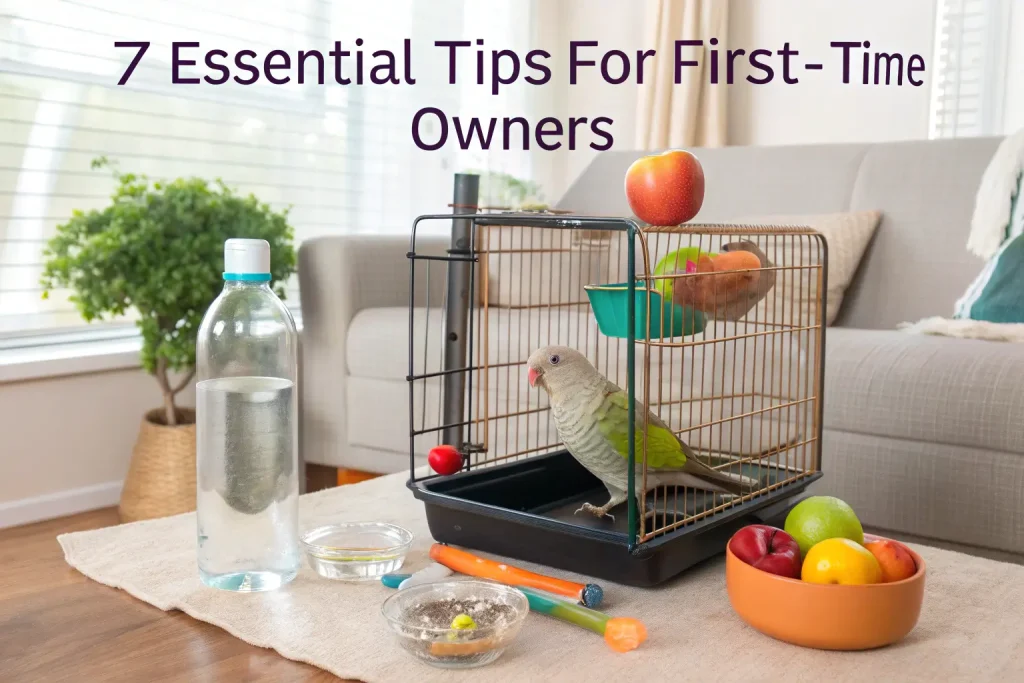
Tips for Caring for Quaker Parrots
When you buy Quaker parrot companions, consider these seven essential tips to ensure your new pet thrives:
1. Provide an Appropriate Cage
Your Quaker needs a spacious cage measuring at least 24″ x 24″ x 30″ with bar spacing no wider than 5/8″. The cage should include multiple perches of varying diameters to promote foot health, several food and water dishes, and plenty of toys for mental stimulation. Position the cage away from drafts, direct sunlight, and kitchens (where fumes from nonstick cookware can be fatal to birds).
2. Offer a Balanced Diet
Establish a nutritionally complete diet consisting primarily of high-quality pellets supplemented with fresh fruits and vegetables. Limit seeds and nuts to occasional treats. Fresh water should always be available, and food dishes should be cleaned daily to prevent bacterial growth.
3. Ensure Regular Exercise
Allow your Quaker at least 3-4 hours outside their cage daily in a bird-proofed room. Remove potential hazards including toxic plants, open windows, ceiling fans, and other pets that might pose a threat. Supervised flight time is crucial for physical health and emotional well-being.
4. Provide Mental Stimulation
Quaker parrots are highly intelligent and can become destructive if bored. Rotate toys regularly and include a variety of puzzle toys, foraging toys, and chewable items. Teaching tricks and commands provides valuable mental exercise and strengthens your bond.
5. Establish a Social Connection
When you buy Quaker parrot pets, commit to spending quality time with them daily. These social birds require regular interaction with their human flock. If you work long hours, consider getting two Quakers for companionship, though be aware they may bond more strongly with each other than with you.
6. Maintain Proper Health Care
Find an avian veterinarian before you buy Quaker parrot pets and schedule annual check-ups. Watch for signs of illness including changes in droppings, reduced appetite, lethargy, breathing difficulties, or unusual behavior. Common health issues include respiratory infections, nutritional deficiencies, and feather plucking due to stress or boredom.
7. Understand the Commitment
Quaker parrots can live 20-30 years with proper care. Before you buy Quaker parrot companions, ensure you’re prepared for this long-term commitment. Consider who might care for your bird during vacations and in the event you can no longer provide care. Also, be prepared for their noisy nature, especially during morning and evening hours when they’re most vocal.
Role in the Ecosystem
Ecological Importance: In their native habitats, Quaker parrots play several important ecological roles. As seed consumers, they help control plant populations and, through imperfect digestion, aid in seed dispersal for various plant species. Their large communal nests also provide housing for other bird species including small parakeets and even some duck species that use abandoned nest chambers.
Impact of Decline: While Quakers aren’t currently threatened with extinction, any significant population decline would impact seed dispersal patterns and potentially affect the various species that cohabit their nests. Additionally, they serve as prey for larger birds of prey, contributing to the food chain.
Feral Impact: In areas where feral populations have established, Quaker parrots have demonstrated both positive and negative ecological impacts. They compete with native species for resources but have also adapted to urban environments where few native birds thrive. Their nests on utility poles have occasionally caused power outages, though many utility companies have developed management strategies to minimize this issue.
Conclusion
The decision to buy Quaker parrot pets should be made with careful consideration of their specific needs, legal status in your area, and your ability to provide appropriate care for potentially decades. These intelligent, social birds offer tremendous rewards as companions, with their playful antics, impressive speaking abilities, and affectionate nature.
However, they also require significant commitment in terms of time, social interaction, proper housing, diet, and mental stimulation. Their vocal nature and potential for destructive behavior when bored means they’re not the right pet for everyone.
If you’ve researched thoroughly, checked local regulations, and are prepared for the responsibility, a Quaker parrot can become a beloved member of your family, offering companionship and entertainment for many years. Remember that responsible ownership includes providing for your bird’s physical and psychological well-being throughout its lifetime, potentially including arrangements for its care after your own.
Consider supporting conservation efforts for wild parrot populations and, if possible, adopt from rescues rather than purchasing birds that may have been wild-caught or bred in suboptimal conditions. By making informed choices about parrot ownership, you’re contributing to the welfare of these remarkable birds both in captivity and in their natural habitats.
Frequently Asked Questions
How much does it cost to buy Quaker parrot pets?
The initial cost to buy Quaker parrot pets typically ranges from $250-$600 depending on age, color mutation, and whether purchased from a breeder or pet store. However, the lifetime cost is much higher when accounting for cage ($150-$300), toys and perches ($100-$200 initially, plus replacements), food ($300-$500 annually), and veterinary care ($100-$200 for annual check-ups, plus potential emergency care).
Are Quaker parrots good for beginners?
Quaker parrots can be suitable for first-time bird owners who have done their research and are prepared for the commitment. They’re relatively small, adaptable, and highly trainable. However, they require significant time, attention, and proper care. Their intelligence means they’ll quickly train you if you don’t train them, potentially developing problematic behaviors if not properly socialized.
How long do Quaker parrots live?
With proper care, Quaker parrots typically live 20-30 years in captivity. This long lifespan represents a significant commitment and should be carefully considered before you buy Quaker parrot pets.
Do Quaker parrots talk?
Yes! Quaker parrots are exceptional talkers, especially considering their moderate size. Many develop vocabularies of 50+ words and can learn simple sentences. Their speech is generally clear and understandable, though individual speaking ability varies. Consistent, patient training starting at a young age yields the best results.
Are Quaker parrots loud?
Quaker parrots are moderately loud, particularly during morning and evening hours when they’re most active. They have a variety of vocalizations ranging from soft chirps to piercing screams. While not as loud as larger parrots like macaws or cockatoos, they are still noisy enough that apartment dwellers should consider neighbor proximity before making a purchase.
Can Quaker parrots be kept with other birds?
Quakers can sometimes be successfully integrated with other birds, particularly if raised together from a young age. However, they can be territorial and may behave aggressively toward new birds introduced to their established space. Never leave different species unsupervised until you’re certain they get along, and always provide separate cages even for birds that play well together.
Why are Quaker parrots illegal in some states?
Quaker parrots are banned in several states due to concerns about their potential to establish feral colonies that could damage crops and native ecosystems. Their exceptional cold tolerance and communal nesting behavior allow them to survive in climates where most parrots could not, leading to established feral populations in numerous cities. Always check current local regulations before you buy Quaker parrot pets.

